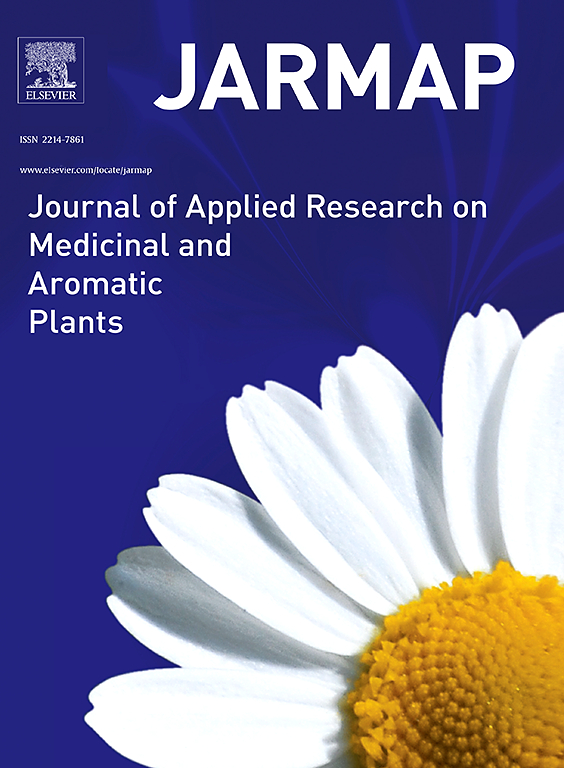Litheness of reproductive traits drives perplexing sexual polymorphism and adaptive strategies in Thymus linearis Benth. across diverse habitats
IF 3.6
2区 农林科学
Q1 PLANT SCIENCES
Journal of Applied Research on Medicinal and Aromatic Plants
Pub Date : 2025-08-10
DOI:10.1016/j.jarmap.2025.100651
引用次数: 0
Abstract
Plasticity in floral traits is often associated with sexual polymorphism that reflects adaptations of plant species to different ecological conditions. Here, we studied the adaptive significance of sexual polymorphism on the reproductive ecology and reproductive success of Thymus linearis −a gynodiocious and duo-dichogamous plant species from the Kashmir Himalayas. All eight studied sites exhibited the coexistence of both female and hermaphrodite flowers with significantly different reproductive attributes. Female flowers were relatively smaller (0.27 ± 0.01 mm in diameter) compared to hermaphrodite flowers (0.32 ± 0.02 mm). In sexual accomplishment of T. linearis, we identified intervention of four floral morphs (A, B, C, and D) with unique form and functionality. These floral morphs varied in the number of pollens per flower, pollen viability, pollen variation, pollen load index, and stigma receptivity. The maximum pollen number was recorded in morph A (3373.3 ± 21.95) and the minimum in morph C (95.12 ± 0.01). The maximum pollen viability was recorded in morph D (87.66 ± 0.61 %), and the minimum in morph B and C (0 %). The maximum pollen variation was observed in morph D (60.53 ± 1.35) and the minimum in morph A (4.53 ± 0.165). The pollen load index was maximum in morph B (0.75) and minimum in morph A (0.25). The maximum duration of stigma receptivity was recorded in morph B (7–8 days) and the minimum in morphs A and D (2 days). The aforementioned species exhibited mixed mating favouring xenogamy over autogamy. The seed set recorded in xenogamy was 78.23 ± 1.34 and 54.57 ± 0.17 % for both female and hermaphrodite flowers, while in autogamy, the seed set recorded was 0 and 44.57 ± 0.17 % for both the female and hermaphrodite flowers. The species is mainly pollinated by honey bees and bumble bees. The research findings on the reproductive biology and sexual polymorphism of T. linearis will provide valuable insights for the development of effective conservation and breeding strategies.
生殖性状的轻盈性驱动着令人困惑的性多态性和适应策略。跨越不同的栖息地
花性状的可塑性通常与性多态性有关,反映了植物物种对不同生态条件的适应。本文研究了性多态性对克什米尔地区一种双雌双花植物——胸腺草(thyymus linearis)的生殖生态和繁殖成功的适应意义。所有8个研究地点均显示雌花和雌雄同体花共存,但生殖特性差异显著。雌花的直径为0.27 ± 0.01 mm,而雌雄同体的直径为0.32 ± 0.02 mm。我们发现了四种具有独特形态和功能的花型(A、B、C和D)的干预。这些花型在每朵花的花粉数量、花粉活力、花粉变异、花粉负荷指数和柱头接受性等方面都有差异。花粉数量以形态A最多(3373.3 ± 21.95),形态C最少(95.12 ± 0.01)。花粉活力最高的是形态D(87.66 ± 0.61 %),最小的是形态B和C(0 %)。花粉变异最大的是形态D(60.53 ± 1.35),最小的是形态A(4.53 ± 0.165)。花粉负荷指数以形态B最高(0.75),形态A最低(0.25)。柱头接受期最长的是B型(7 ~ 8 D),最短的是A型和D型(2 D)。上述物种表现出混合交配倾向于异种通婚而不是自婚。雌花和雌雄同体花的结实率分别为78.23 ± 1.34和54.57 ± 0.17 %,而雌雄同体花的结实率分别为0和44.57 ± 0.17 %。该物种主要由蜜蜂和大黄蜂授粉。研究结果将为制定有效的保护和育种策略提供有价值的见解。
本文章由计算机程序翻译,如有差异,请以英文原文为准。
求助全文
约1分钟内获得全文
求助全文
来源期刊

Journal of Applied Research on Medicinal and Aromatic Plants
Pharmacology, Toxicology and Pharmaceutics-Drug Discovery
CiteScore
6.40
自引率
7.70%
发文量
80
审稿时长
41 days
期刊介绍:
JARMAP is a peer reviewed and multidisciplinary communication platform, covering all aspects of the raw material supply chain of medicinal and aromatic plants. JARMAP aims to improve production of tailor made commodities by addressing the various requirements of manufacturers of herbal medicines, herbal teas, seasoning herbs, food and feed supplements and cosmetics. JARMAP covers research on genetic resources, breeding, wild-collection, domestication, propagation, cultivation, phytopathology and plant protection, mechanization, conservation, processing, quality assurance, analytics and economics. JARMAP publishes reviews, original research articles and short communications related to research.
 求助内容:
求助内容: 应助结果提醒方式:
应助结果提醒方式:


